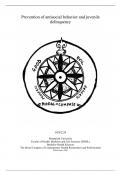Prevention of antisocial behavior and juvenile
delinquency
GZW2224
Maastricht University
Faculty of Health, Medicine and Life Sciences (FHML)
Bachelor Health Sciences
The Moral Compass of Contemporary Health Researchers and Professionals
Word count: 2467
, Introduction of the case
"Delinquent behavior is behavior that is punishable by law" (Laan & van der Blom, 2011). In
the past ten years, juvenile crime has decreased by more than half in the Netherlands.
Nevertheless, the number of registered underage suspects rose again in 2019 for the first time
in ten years (Central Bureau of Statistics, 2020). In general, there is a decrease in the number
of juvenile delinquents. However, it appears that a third of the convicted juveniles reoffend
within two years (Rijksoverheid, 2019).
The prevention of juvenile crime is a complex matter for which there is no simple
solution. Complex, because the cause of the display of criminal behavior is multifactorial. All
factors are important, but their accumulation is decisive (de Groot, Steketee, Boutellier,
Braam, & Tierolf, 2007). Studying risk factors is a way of distinguishing between those who
are more likely to engage in criminal behavior and provides an opportunity to tailor programs
(Shader, 2004). Risk factors can be divided into different domains: individual, family, school,
peer group and community. Consider factors such as: exposure to violence, low
socioeconomic status, weak social ties, family conflict (Shader, 2004).
Juvenile delinquency has many individual and social consequences. Financial damage,
but also emotional problems (Central Bureau of Statistics, 2000). This is why juvenile crime
is a public health problem. Not only in the Netherlands, in London too serious violence under
youth is a big problem. UK ministers have made the announcement of a national ‘public
health duty’ to tackle serious violence, including knife crime (The Guardian, 2019).
The tackling of criminal youth groups is also a priority for the Public Prosecution
Service in the Netherlands. The combination of prevention, care and repression must ensure
an effective approach (OM, n.d.). The focus has shifted to prevention interventions and
identifying youth at-risk at an early age. This is considered crucial for the reduction of
juvenile delinquency (Horstkötter, Berghmans, & De Wert, 2014).
An example of a prevention program is Functional Family Therapy (FFT). It is an
effective program for youth at-risk and their families. FFT has been implemented in different
treatment contexts and with culturally diverse clients looking at risk and protective factors.
The family-oriented approach can reduce recidivism and/or prevent the development of
juvenile delinquency (Sexton & Alexander, 2000).
Despite the effectiveness of various prevention programs, it appears that youth who
participated in prevention programs also experience negative side effects (Horstkötter,
Berghmans, de Ruiter, Krumreich, & de Wert, 2012). Negative side effects that occurred in
the FFT were, for example, worsening of the problematic symptoms or initiating an





